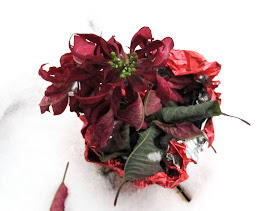
Stormy days are a great time to sit with a mug of coffee, glower out the window, be grateful to be indoors, and muse about things that puzzle me. I've had something on my mind for a couple of weeks, but it's taken me that long to pull my thoughts together in a way that I hope will encourage and challenge other bloggers in a happy, intriguing way.
One of the things I've noticed since getting really back into blogging and reading is that there really are a lot of gardening and garden-related blogs out there. And I mean a LOT. I don't remember how many there were at Blotanical when Stuart launched the site nearly 3 years ago, but I knew and read a good many of them. Some had been blogging for a while. Others started up and then joined Blotanical as word of the site spread. A visit to the site this morning shows me some 900 on the 'most visits' list, yet one blog is ranked as # 1364 in 'most favourited'. Let's just say there are a huge number, some of which I've never visited. That doesn't include those who don't belong to Blotanical, either. And I know this is the same experience for many of us. Can't possibly read them all regularly, or even visit them all regularly.

There are so many ways to keep track of other blogs now, that it gets confusing. We can 'fave' blogs and blotanists at Blotanical. We can 'follow' bloggers through Facebook, or become a fan of them. We can follow thru Google Friend Connect, or by various widgets through Blogger, and I assume through Wordpress and Typepad. And then there's Twitter...
But there are still so many out there that get very few visits, (at least via Blotanical), and very few if any comments. And for some reason, I feel really badly about that. Because so many of these blogs are very well written, with good information, excellent photographs, strong and charming personalities. They deserve to be read, commented upon, supported. Not everyone has the same interests, of course, and there's sometimes a language barrier with bloggers from other countries.
I know that people blog for a variety of reasons, but obviously most of us put thoughts out there on the Internet to communicate with others, share our thoughts and experiences. That makes it safe to assume that most want to attract readers, commenters, followers, etc. So, what can we longtime bloggers, Blotanical veterans, etc, do to encourage and help out other bloggers in raising their profiles?

From sleuthing my way around the Web and following some of the more active bloggers, I have a couple of observations. There are people who regularly visit other blogs and leave lovely, well thought out, funny, wise, comments. Some of these same people also participate a good deal on Blotanical, picking posts, sending welcoming notes to newer bloggers, dropping in to other bloggers to announce their own recent posts, etc, which helps encourage newer bloggers to participate. I don't want to mention anyone in particular because I don't want to leave anyone OUT, but my hat is certainly off to those who encourage other bloggers.
What I've been wondering is what about if we each--and by each, I mean those who feel like doing this--adopted a new/newish blog (or three or four or a dozen) and regularly visited, commented, put them in our feeds, at the top of our 'faves' lists? Would others notice and spend more time reading those other blogs? What do you think, friends? I'm sure someone has a better idea, and gardeners are great at brainstorming over gardening questions, so why not this? Could we perhaps have a conversation about this, as we while away the winter months and wait for spring?
I hesitate to call what I'm suggesting 'mentoring', which is something I have done in my real-life writing, mentoring newish writers as they entered the wonderful world of freelancing. In fact, I struggled long and hard with even creating this post because several years ago, I did a series of three posts to help out other bloggers, making some suggestions on how to make things easier/attract more readers. I caught flack in emails and also indirectly from several other bloggers who thought I was criticizing the way others blog and trying to get everyone doing things in the same way, which wasn't the intent at all. Oddly enough, several of those critics no longer blog.

This has nothing to do with bloomingwriter's visitors, for the record--I'm more than happy with my own blog's statistics, I don't do awards or competitions of that nature, and I have the privilege of receiving wonderful comments from around the globe. I'd just like others to receive more visitors and support, because they deserve such accolades. When I was trying to decide whether I should overhaul my blog, close it down, or just carry on as I could, I received the most wonderful support and encouragement. It was truly humbling, and proves my point about this community of gardeners and writers. Y'all are just awesome.
That's enough out of me for today. I'm looking forward to the conversation among this community of generous, fun and talented people. That includes those of you who are newer to blogging--what do YOU want from the community? What's working for you, what do you wish could be improved? If it merits, I'll do a follow up post based on how the conversation flows.















































